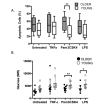Reduced bioenergetics and toll-like receptor 1 function in human polymorphonuclear leukocytes in aging
- PMID: 24595889
- PMCID: PMC3969281
- DOI: 10.18632/aging.100642
Reduced bioenergetics and toll-like receptor 1 function in human polymorphonuclear leukocytes in aging
Abstract
Aging is associated with a progressive decline in immune function (immunosenescence) resulting in an increased susceptibility to viral and bacterial infections. Here we show reduced expression of Toll-like receptor 1 (TLR1) in polymorphonuclear leukocytes (PMN) and an underlying age-dependent deficiency in PMN bioenergetics. In older (>65 years) adults, stimulation through TLR1 led to lower activation of integrins (CD11b and CD18), lower production of the chemokine IL-8, and lower levels of the phosphorylated signaling intermediate p38 MAP kinase than in PMN from younger donors (21-30 years). In addition, loss of CD62L, a marker of PMN activation, was reduced in PMN of older adults stimulated through multiple pathways. Rescue of PMN from apoptosis by stimulation with TLR1 was reduced in PMN from older adults. In seeking an explanation for effects of aging across multiple pathways, we examined PMN energy utilization and found that glucose uptake after stimulation through TLR1 was dramatically lower in PMN of older adults. Our results demonstrate a reduction in TLR1 expression and TLR1-mediated responses in PMN with aging, and reduced efficiency of bioenergetics in PMN. These changes likely contribute to reduced PMN efficiency in aging through multiple aspects of PMN function and suggest potential therapeutic opportunities.
Conflict of interest statement
The authors of this manuscript have no conflict of interest to declare.
Figures





References
-
- Finkel T, Holbrook NJ. Oxidants, oxidative stress and the biology of ageing. Nature. 2000;408(6809):239–247. - PubMed
Publication types
MeSH terms
Substances
Grants and funding
LinkOut - more resources
Full Text Sources
Other Literature Sources
Medical
Research Materials

